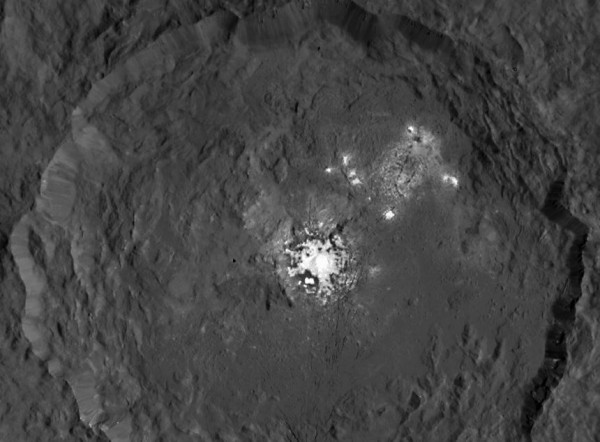
NASA released this great new image of the famous bright spots on Ceres today (September 9, 2015). The image is from the Dawn spacecraft, now in a lower orbit around the little world, at an altitude of 915 miles (1,470 kilometers) above Ceres’ surface when this image was acquired. The image shows what scientists now call Occator crater on Ceres, where – as you can see – several spots are much brighter than the rest of Ceres’ surface. There’s still no confirmation yet on what the bright spots might be, but they’re definitely looking more natural – less like gleaming headlights than like ordinary geologic features – than before.
Marc Rayman, Dawn’s chief engineer and mission director based at NASA’s Jet Propulsion Laboratory, Pasadena, California, said in the NASA statement:
Dawn has transformed what was so recently a few bright dots into a complex and beautiful, gleaming landscape.
Soon, the scientific analysis will reveal the geological and chemical nature of this mysterious and mesmerizing extraterrestrial scenery.
This view is a composite of two images of Occator: one using a short exposure that captures the detail in the bright spots, and one where the background surface is captured at normal exposure. These are the closest-yet views of Occator crater, with a resolution of 450 feet (140 meters) per pixel.
Scientists have produced animations that provide a virtual fly-around of the crater, including a colorful topographic map.
The images were obtained by Dawn during the mission’s High Altitude Mapping Orbit (HAMO) phase. NASA said:
The spacecraft has already completed two 11-day cycles of mapping the surface of Ceres from its current altitude, and began the third on Sept. 9. Dawn will map all of Ceres six times over the next two months. Each cycle consists of 14 orbits. By imaging Ceres at a slightly different angle in each mapping cycle, Dawn scientists will be able to assemble stereo views and construct 3-D maps.
Bottom line: On September 9, 2015, NASA released the most detailed view yet of the mysterious bright spots on Ceres.











